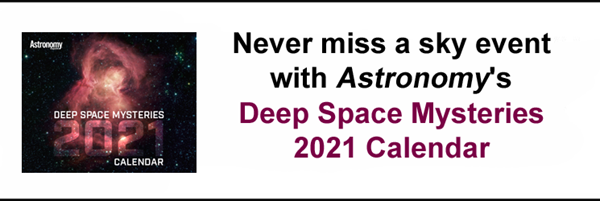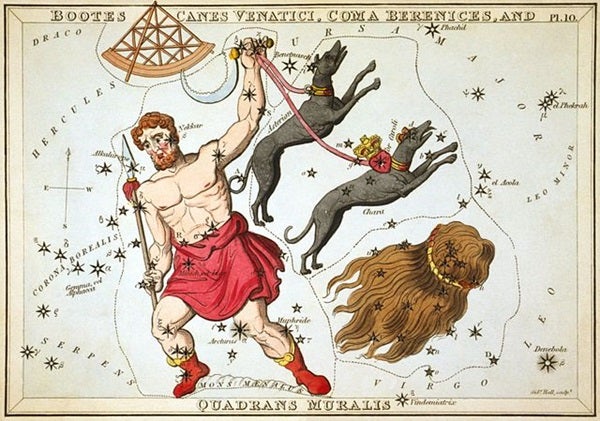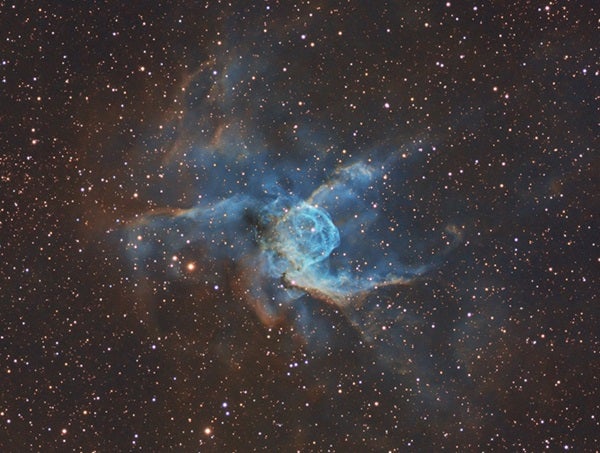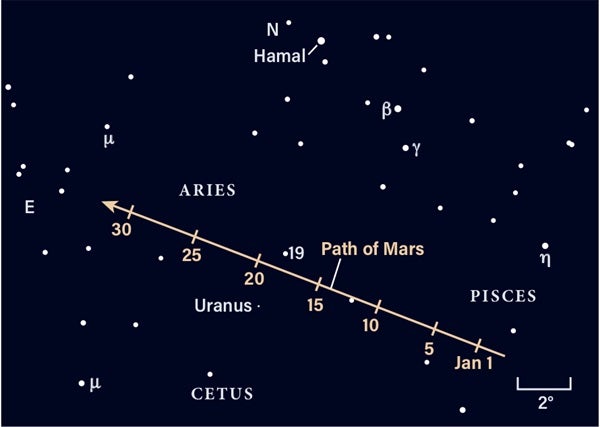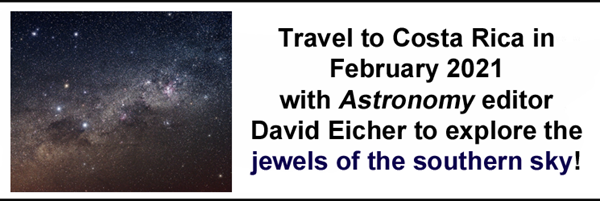You may have heard of the Pleiades (M45), but many people are less familiar with their nearby neighbor, the Hyades. That’s because the latter is a more widespread cluster and, as a result, looks a little less striking than the more densely packed Pleiades.
But the Hyades is a great wintertime target in its own right, already relatively high above the eastern horizon after sunset. Roughly 12° below the Pleiades after dark, the Hyades make up the glittering V of Taurus’ nose. At 151 light-years away, the Hyades is the closest known open cluster to Earth, containing around 400 stars within 5.5°. Many of those stars are easily visible with binoculars, and a telescope will bring even more into view.
Nearby on the sky but not actually associated with the cluster is Aldebaran, the bright red eye of the Bull. Still, it’s another great target for binoculars and telescopes alike — compare and contrast its color with Orion’s shoulder Betelgeuse, another red giant star. Which one is redder, and which appears more orange? What do the differences in color mean? (Here’s a hint: Blue stars are hottest and red stars are coolest, with the rest falling on a color-temperature scale in between.)
Sunrise*: 7:22 A.M.
Sunset: 4:46 P.M.
Moonrise: 7:24 P.M.
Moonset: 9:30 A.M.
Moon Phase: Waning gibbous (93%)
*Times for sunrise, sunset, moonrise, and moonset are given in local time from 40° N 90° W. The Moon’s illumination is given at 12 P.M. local time from the same location.
Earth reaches perihelion — the closest point to the Sun in our planet’s orbit around our star — at 9 A.M. EST. At that time, we will sit 91.4 million miles (147 million kilometers) from the Sun. We will reach aphelion — the farthest point from the Sun — six months from now, on July 5.
In honor of our home star, consider some daytime solar observing. It’s easy, as long as you make sure to take some simple precautions. If you have a solar filter for your telescope, make sure it is well fitted and cover your finder scope to prevent accidentally looking at the Sun through an unfiltered lens.
Alternatively, you can make a low-tech pinhole camera using materials likely lying around your home. Or you can use a small handheld mirror to reflect an image of the Sun onto a nearby wall. The closer you stand to the wall, the smaller the image will be, but the sharper it will appear. Stand farther away and it will get bigger, but also blurrier.
These types of solar observing activities are great for all ages, but make sure no one gets curious and turns around to look at the Sun directly.
Sunrise: 7:22 A.M.
Sunset: 4:47 P.M.
Moonrise: 8:32 P.M.
Moonset: 10:07 A.M.
Moon Phase: Waning gibbous (86%)
The Quadrantid meteor shower peaks this morning around 9:30 A.M. EST. That makes the hours before sunrise the best time to seek out shower meteors spraying from the radiant in Boötes. This shower is actually named for the now-extinct constellation that originally housed its radiant, Quadrans Muralis. That constellation appeared on star charts since is creation in 1795 until 1922, when the International Astronomical Union omitted it when creating the 88 standardized constellations we use today.
The Quadrantids’ radiant rises after midnight — not long after the Moon has also risen, washing out much of the dark sky. Still, you’ll likely be able to find Arcturus, Boötes brightest star; the radiant lies 32° north-northwest of the star. One easy way to find the radiant is to draw a line between Spica in Virgo through Arcturus — follow that line in the same direction for the same distance that lies between those two stars, and you’ll land right on target.
Despite the bright Moon, the Quadrantid meteor shower is known for its bright fireballs, so it’s certainly worth stepping outside this morning if your skies are clear. What’s more, the shower’s expected maximum rate is a whopping 120 meteors per hour, increasing the chances that you’ll see some streaks overhead, even under poor conditions.
Sunrise: 7:22 A.M.
Sunset: 4:47 P.M.
Moonrise: 9:42 P.M.
Moonset: 10:39 A.M.
Moon Phase: Waning gibbous (78%)
Monday, January 4
The Orion Nebula (M42) is the Hunter’s most famous nebula, but it’s certainly not the only one within his borders. Tonight, try for M78, located just 2.5° northeast of Alnitak, the leftmost star in his belt when facing the sky.
This beautiful reflection nebula will show up in large binoculars and small scopes, but real detail will only emerge for those using larger apertures. Still, it’s a great target for any observer when the skies are dark, so make sure to get your observing in before moonrise — this little gem can easily be overtaken by light pollution. If you want an even bigger challenge, look for two 10th-magnitude stars north of the nebula’s smoky border: According to binocular observer Steve Tonkin, one of these has the tiniest wisp of nebulosity visible under the right conditions.
As long as you’re in the area, take some time to swing down to M42 for a visit. This always-stunning nebula holds several young, bright stars nestled in its center. They should really pop out even under low power. The Orion Nebula is also bright enough that you should be able to observe it past moonrise, but its detail may begin to diminish under the brightening sky.
Sunrise: 7:22 A.M.
Sunset: 4:48 P.M.
Moonrise: 10:50 P.M.
Moonset: 11:09 A.M.
Moon Phase: Waning gibbous (68%)
A favorite wintertime constellation is rising a few hours after dark: Canis Major the Big Dog. Famous for containing the Northern Hemisphere’s brightest star, Sirius, Canis Major holds other delectable sky treats as well.
One of the best is the open cluster M41, a dazzling sight through binoculars or a small telescope. (If you have good skies and you let the constellation rise higher, you may also spot it with the naked eye.) M41 is easy to locate — you’ll find it 4° south of Sirius, housed within the stars outlining Canis Major’s body, in the region often depicted as the dog’s neck. M41 spans some 25 light-years in space and is roughly 200 million years old — definitely young by stellar standards. It lies a little over 2,000 light-years away.
If you’re looking for something a little more challenging, try Thor’s Helmet — more formally known as NGC 2359. This emission nebula spans some 30 light-years and in its center is a hot Wolf-Rayet star nearing the end of its short life; when its time is up, it will explode in a brilliant supernova.
The nebula is located 8.8° east-northeast of Sirius. To bring out any detail, you’ll want to use an 8-inch or larger telescope; alternatively, a long-exposure photograph even through a slightly smaller instrument may start to reveal the nebula’s delicate detail.
Sunrise: 7:22 A.M.
Sunset: 4:49 P.M.
Moonrise: 12:00 A.M.
Moonset: 11:37 A.M.
Moon Phase: Waning gibbous (57%)
Wednesday, January 6
Last Quarter Moon occurs today at 4:37 A.M. EST. According to Astronomy columnist Bob Berman, Last (or Third) Quarter Moon is “our strange, orphaned, unobserved Moon” because lunar observers rarely think to look for the Moon before dawn.
But now that you know better, consider rising early this morning to look at the Moon. In this phase, the crater Copernicus is on full display just south of Mare Imbrium. Astronomers know it is young because it’s remarkably well preserved and surrounded by a bright system of rays. The crater has several central mountains (a common feature) likely created when deep lunar material rebounded following the impact itself.
Other easy-to-find features visible during Last Quarter are the Apennine Mountains, which curve around the base of Mare Imbrium and appear to point right to Copernicus. And in the lunar south is the large crater Clavius, which contains a unique curl of small craterlets within its large, low walls.
Of course, you don’t have to get up early to observe the Last Quarter Moon. It’s up all morning and sets around noon, so you can follow it even as the Sun rises. Just take care when using any optical aid to observe the Moon — even though it’s relatively far from the Sun, you don’t want to swing your gaze around and get an eyeful of concentrated sunlight.
Sunrise: 7:22 A.M.
Sunset: 4:50 P.M.
Moonrise: —
Moonset: 12:04 P.M.
Moon Phase: Waning crescent (46%)
Mars and Uranus rule the evening skies, now both sharing the constellation Aries the Ram. (Mars crossed the border from Pisces two days ago.) In fact, you can use the Red Planet as a signpost to find the distant ice giant all month.
Tonight, Uranus (magnitude 5.8) lies 6.5° east-northeast of magnitude –0.3 Mars. The latter will draw closer to the former as the days go by, and the two will pass closest later this month. Their relative positions change so rapidly because Mars is much closer than Uranus, and so appears to track much more quickly across the background stars. Even as Mars covers significant ground this month, Uranus sticks close to the magnitude 5.7 star 19 Arietis. You can tell them apart because the planet will appear as a slightly “flatter” blue-gray disk.
Mars itself is now 89 million miles (143 million km) from Earth. It appears 10″ across and is best viewed through larger (8-inch or greater) scopes if you want to glean any detail. Alternatively, if you have a smaller scope but experience with astrophotography or video capture, you’ll likely also attain good views.
Sunrise: 7:22 A.M.
Sunset: 4:51 P.M.
Moonrise: 1:11 A.M.
Moonset: 12:33 P.M.
Moon Phase: Waning crescent (35%)
Friday, January 8
The tiny planet Mercury has reappeared in the skies, now an evening star quickly approaching Jupiter and Saturn in the southwest after sunset. It’s still a bit tricky to catch — 20 minutes after sunset, Mercury is just 4.5° high. You’ll find it a little more than 4° below Jupiter, which is a bright magnitude –2. Mercury glows at magnitude –0.9, while Saturn (which sits between them) is a dimmer 0.5.
All three planets are in the southwestern portion of Capricornus the Sea Goat — but take note of their relative positions, because they’re going to change. Tomorrow evening, Mercury will sit less than 2° south of Saturn, then keep moving and soon pass the gas giants in the sky.
Ultimately, Mercury will meet up with a very young Moon on January 13 — stay tuned for how to see that stunning event.
Sunrise: 7:22 A.M.
Sunset: 4:52 P.M.
Moonrise: 2:22 A.M.
Moonset: 1:06 P.M.
Moon Phase: Waning crescent (24%)


